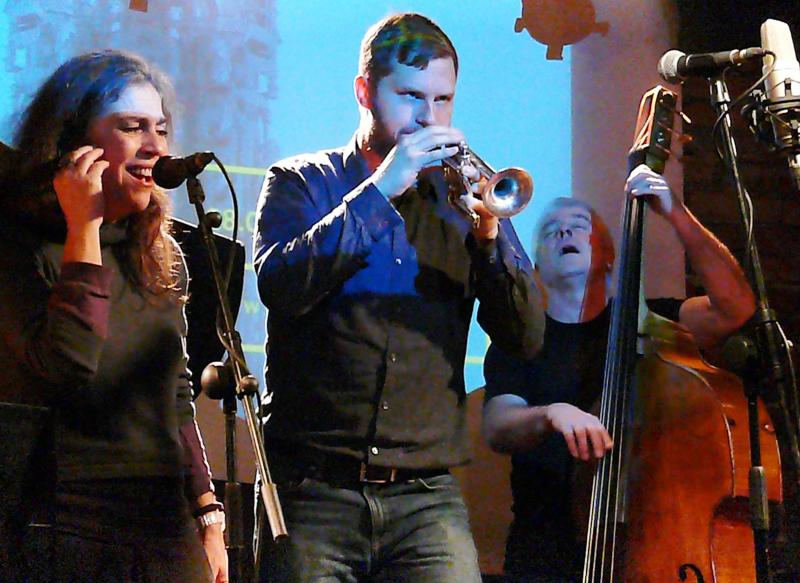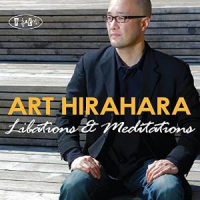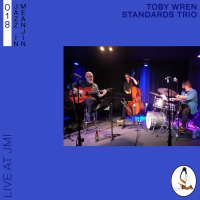Home » Jazz Articles » Live Review » Barry Guy Blue Shroud Band in Krakow, Poland
Barry Guy Blue Shroud Band in Krakow, Poland

Alchemia
Krakow, Poland
November 18-22, 2014
Chapter Index
The Blue Shroud
Krakow Jazz Autumn
Small Group Formations
Day One
Day Two
Day Three
Polish Musicians
Post Script
The Blue Shroud
From the first notes the audience was spell bound. You could hear the proverbial pin drop. Trumpeter Peter Evans circular breathed a barely audible whistle, which he gradually ramped up to siren intensity. But then he went further, his piercing shriek taking on the visceral dimensions of an air raid claxon. A powerful group crescendo, including a machine gun rat-a-tat from the twin trapsets of Ramón López and Lucas Niggli and thunderous slabs of sound from Agusti Fernandez under the bonnet of the piano instantly evoked not only bombings, but also other wars and conflicts around the world.
Such strong feelings were entirely appropriate for "The Blue Shroud," a new piece by English composer and bassist Barry Guy, which received its world premiere at the 9th Krakow Jazz Autumn. Inspired by Picasso's masterpiece Guernica and the events which provoked it, the work just might be the crowning achievement in the Englishman's long and varied career.
At age 67, Guy can look back on an unprecedented body of work, which spans the classical, contemporary, jazz and improv worlds. Renowned as a sensitive interpreter of baroque music (the Englishman appears on over 150 recordings, and has performed with all the specialist early music ensembles), he regularly juxtaposes renditions of the works of the seventeenth century composer H.I.F. Biber alongside his own compositions in concert and on his albums with his partner, violinist Maya Homburger, such as the splendidTales Of Enchantment (Intakt, 2012).
In jazz circles the two strands for which he is best known can be seen as opposite ends of the spectrum. At one extreme lies the high voltage improv, showcased to staggering effect in a long standing trio of compatriots saxophonist Evan Parker and drummer Paul Lytton, while at the other stands the large scale charts of the London Jazz Composers Orchestra, seen in the last incarnation on Harmos Live At Schaffhausen (Intakt, 2012), and his scaled back Barry Guy New Orchestra, evidenced on Amphi + Radio Rondo (Intakt, 2014), their third release.
However Guy's constructs seek to reconcile the two poles by devising settings which stimulate and frame spontaneous colloquy between participants, often spotlighting already extant configurations. "The Blue Shroud" followed that template, but took the interweaving of diverse threads one step further by including fragments of baroque works alongside jazz and improv. In order to realize his singular vision, Guy hand-picked a multinational crew which could meet the technical demands of the baroque, yet wield the unfettered imagination required for the improvisation.
In his program notes, Guy explained that "there were three strands that informed the writing of "The Blue Shroud." The bombing in 1937 of the Basque city of Guernica by German Condor Legion pilots at the invitation of Franco, the painting by Pablo Picasso that arose following the event, and in more recent times (2003) a blue drape that was hung over a tapestry reproduction of the Guernica painting in the United Nations building before US Secretary of State Colin Powell delivered his case for invading Iraq to TV viewers and the world in general. Incontestably, the Guernica image of death, panic and mayhem would have sent a far too literal message about the horrors of war to the receivers of Powell's statement."
If you told most jazz fans that a gig was going to involve a specially convened ensemble playing a composition bringing together baroque music, improvisation and jazz they would likely head for the hills, having endured one too many special festival commissions in the past. In Krakow that would have been a very big mistake, and not just because it's snowy up there.
In its entirety the work dazzled as a 80-minute multifaceted journey through transcendent melodies, whipcrack orchestral interjections, intricate rhythmic figures, solo and small group outbursts, song and recitation. Guy's triumph was that all those disparate elements cohered into a singular experience. After the startling introduction, changes came thick and fast, as first delicate strings then reed shimmies transformed the emotional direction. A lyric Spanish-tinged duet between classical guitarist Ben Dwyer and Guy led into a lush setting for Greek vocalist Savina Yannatou's singing of a specially written text by Irish poet Kerry Hardie (a former neighbour of Guy when he lived in Ireland), entitled "Symbols of Guernica."
Guy revisited a gambit familiar from Theoria (Intakt, 1992), by sequencing concentrated eruptions of small group improvisation, which switched from one to another in swift succession. The disparate flavors and textures served to both keep things fresh and disorientate. Guy cued the transformations while still playing, pointing with his bow in one hand, while tapping the fingerboard with the other. Among the combinations which stood out were Evans' playful duet with Fernandez, the pianist's alliance with German reedman Michael Niesemann's alto saxophone, and young saxophonist Julius Gabriel's snorting baritone pyrotechnics. Later the gambit resurfaced in a series of quick changing twosomes with Lopez' drums the constant ingredient, which in their briskness resembled a session with a particularly picky speed dater.
Thorny rhetoric from the trio of Guy, Dwyer and Yannatou's improvising voice re-emerged several times to form a recurrent motif. Yannatou shifted between anguished reminders of human pain and suffering, and serene and elegant singing of the poem's stark imagery. One interchange with the split tones generated by Torben Snekkestad's reed trumpet was particularly striking. As well has Hardie's words, she also wove in spoken phrases which Hardie expressly selected from Powell's speech, relating to UN Security Council Resolution 1441 and weapons of mass destruction.
Perhaps Niesemann's part best illustrated the dual requirements of the score. A professor at the prestigious Essen Folkwang University, he has recorded together with Guy on recitals of Bach with Sir John Eliot Gardiner's English Baroque Soloists, but is also active in jazz and contemporary realms. At times he took on the role which English reedman Trevor Watts has filled in Guy's work in the past as an impassioned soloist soaring through and above a surging orchestral vamp. Yet subsequently he also played the baroque oboe d'amore in the "Agnus Dei" from Johann Sebastian Bach's Mass in D Minor. And did both superbly.
Guy's co-option of works by Biber and Bach meant that the piece boasted some of the most beautiful tunes ever written, which heightened the poignancy of both the vocal texts and the musical settings from which they issued. Perhaps after all the abrupt cuts, the slow natural transitions took on a seamless aspect, meaning that the baroque sat comfortably amid the modern. The timeless melodies served to convey the resilience of the human spirit as well as the promise of redemption. The overall impact was incredibly moving. After the "Agnus Dei," a freewheeling coda brought proceedings to a close, eliciting a rapturous standing ovation from the enthralled crowd.
Although the concert took place in a studio in Radio Krakow, the performance was not recorded and there are no dates set for the unit to reassemble. "The Blue Shroud" convinced as stunning on first hearing, but would reveal many more facets on repeated listening. One can only hope that funding can be found to permit a studio session.
Krakow Jazz Autumn
The premier of The Blue Shroud represented the culmination of the annual autumn jazz extravaganza—Krakow Jazz Autumn—in the imposing Polish city. Now in its ninth year, the festival has become an established attraction in the jazz calendar. It's impossible to see all the acts on the bill without spending several months in residence as they come in clusters from late September through to late November. Famed for its vibrant avant jazz scene, the city attracts top notch draws from across the globe.
On the bill earlier in 2014 were reed titan Peter Brötzmann and Scandinavian supergroup The Thing in consort with the DKV Trio featuring saxophonist Ken Vandermark and drummer Hamid Drake. Other enticing outfits included a group including saxophonists Ingrid Laubrock and Ab Baars, a solo concert from bassist Joëlle Léandre, Japanese/French quartet Kaze, containing Satoko Fujii and husband Natsuki Tamura, as well as a range of Polish ensembles.
Alchemia, where most of the action took place, nestles in the heart of Kazimierz, the hip former Jewish quarter of Krakow. Although unprepossessing from the outside, once through the double doors a welcoming vibe awaited. The dim lights of the bar masked the way to an intimate performance space in the cellar. Any number of famous sessions have been waxed here, most notably the Vandermark 5's 12 CD marathon of the same name (Not Two, 2005), but also Mats Gustafsson's Hidros 6 (Not Two, 2014) box set, and indeed two residencies by Guy's New Orchestra in 2010 (which resulted in the splendid Mad Dogs (Not Two, 2013)) and 2012 (begetting Mad Dogs On The Loose (Not Two, 2014)).
Small Group Formations
During the days leading up to the final concert, Guy rehearsed the band through his score, while in the evening they broke into smaller subdivisions to improvise freely. That plan not only provided a way to promote familiarity and let off steam after a long day's intense rehearsal, but also sowed the seed for some of the improvisatory passages in the longer work. That was the case particularly with the nightly solo spots for Dwyer's guitar, the saxophone quartet on the second evening, Niesemann's highly charged alto excursions, and the skirmish between piano and trumpet.
Each night there were three sets, each comprising up to three separate groupings. While everyone had links to the bassist, many of the participants had not worked together. So it was inevitable that there would be some first meetings among the small formations. Often these were some of the most potent of the short engagements. Guy's presence was also a surefire indicator of quality.
Individually, he stands as one of the world's preeminent improvisers on bass, having developed the quicksilver aesthetic first posited by Scott LaFaro to its logical extreme. In performance Guy simply has to be seen to be believed. His spurts of hyperactivity combined precise articulation, a plethora of extended approaches and seemingly inexhaustible stamina. He thrived on opposites and tension: between pizzicato and arco; between deep resonance and a nimble upper register; and between straight and idiosyncratic techniques.
While with one hand he might brandish a mallet to mine overtones from the strings both above and below the bridge, with the other he would simultaneously finger rapidly evolving pitches and chords. Then afterwards he might insert knitting needles between the strings to act as temporary bridges which modified the tuning and at the same time add a random metallic shimmer. His use of a volume pedal meant that even the most subtle effects, such as his ringing harmonics, could hold their own in dialogue. But whatever he did was informed by an acute musical sensibility. It was never just technique for its own sake.
Day One
While the overall standard of the sessions was astoundingly high, there were some sets that stood out even more than others. Unsurprisingly the most seasoned improvisers proved the most accomplished, but even the chamber specialists gave a strong account of themselves on less conventional turf. On the first night highlights included the opening solo set from Spanish pianist Agusti Fernandez, and his subsequent duet with trumpeter Evans, and the duos of Evans and Norwegian reedman Snekkestad, and Guy and Greek vocalist Yannatou.
Fernandez' first gesture was electrifying: swiping a wood block across the strings inside the piano to magic a wild gust of sound. It announced a panoply of percussiveness from which occasional plucked notes materialized as if by accident. Few other pianists can equal the Catalan's dexterity and resourcefulness in extracting maximum potential from his instrument. Amid the multiplying overtones, Fernandez drew out an almost vocal quality from the piano interior. As a very hushed groaning passage subsided, Evans joined the pianist.
With the bell of his trumpet over the mic, he created a resounding bass drone, which the pianist punctuated with shrill plucks from the piano interior. Purposeful interplay ensued, testament to prior collaboration, not only on disc with Mats Gustafsson, but also as a duo on tour. Fernandez paralleled the American's rapid fire exhortations with dense muscular runs. One wonderful moment of synchronicity saw both seemingly independently settle on a trilled phrase. Evans' speed of thought and reaction provides a severe test for anyone he shares the stage with, but Fernandez was equal to the task.
Likely the duo of Evans and Norwegian reedman Snekkestad will also surface on disc at some point, such was the success of their inaugural meeting. After exchanging growls and quiet susurrations, Snekkestad using a trumpet with a reed mouthpiece, the pair exuberantly braided squalling tones. Snekkestad sneaked his soprano into his mouth next to the reed trumpet to conjure lacerating exclamations, before focusing wholly on the straight horn. Seated next to each other, circular breathing through a brass lexicon, the twosome appeared every inch terrible twins.
Yannatou has featured in previous Guy projects, including "Time Passing" at the 2013 Huddersfield Contemporary Music Festival, as well as in a pairing captured live on Attikos (Maya, 2010). On this occasion Yannatou constrained her wordless ululations, muffled stutters and introspective screams within a low level passion, which allowed full rein to Guy's exquisite filigree runs. Arco swoops interrupted flurries of pizzicato notes and slurs akin to Yannatou's vocal sighs. It was as if they conversed in an intimate discourse in an alien language complete with its own syntax, which was at times stirring, mournful and ethereal.
Day Two
The second evening furnished a study in polarities. The opening combination of Guy, Niggli and violinist Maya Homburger performed "Rondo for Nine Birds," a composition by Guy inspired by a picture which adorns the wall of their home. In the through-composed piece, the players returned at regular intervals to a jaunty ditty, interposed between diverse vignettes. Niggli interpreted the repeating theme differently each time, varying between fingers and sticks, and between exact and loose, while Homburger and Guy's parts intertwined, sometimes austere but at others nervy and staccato.
If much of the first set dwelt in the chamber, then the quartet of Niggli, Lopez, Fernandez and Evans. was probably in the garage, with a default setting of all out aural assault. Evans' bravura trumpet cut through the waves of noise with aplomb, dipping into the troughs and skimming above the surf. He and Fernandez once again united in a high energy face off, fuelled by a clattering accompaniment. But there were astonishing contrasts too, as when Evans key pad popping prompted the Spaniard to delve into piano's innards. But the respite was brief. Fernandez hammered the keys, smashed his forearms and used his fingers in sewing machine motion, while Niggli excitedly bounced on his stool translating the fervor into apocalyptic tumult.
Day Three
On the third night high points included the duo of Guy and Niesemann, the larger grouping growing out of the initial threesome of Godard, French violist Fanny Paccoud and Guy, and the Aurora Trio with Evans and Yannatou. Niesemann alerted unsuspecting listeners to his qualities with a searing clarion call on his alto saxophone. It heralded not a maelstrom, but an interlude of subdued intensity in which plaintive alto vied with fluttering bass. That pattern of alternating animation and meditation continued, as Niesemann's short guttural phrases matched Guy's sudden switches between bow and hands. Such was the combustive zeal, that their first selection peaked in frenetic oratory, as Niesemann screeched multiphonics, with the veins on his neck looking ready to pop.
Paradoxically given their backgrounds, Paccoud, Godard and Guy gave rise to some of the most swinging sections of the three nights. From the serpent, a convoluted wooden ancestor of the tuba, Godard drew a jazzy buzz, which encouraged Guy into a relaxed lope. When Paccoud entered from backstage she picked out Godard's rhythm on her viola, before sawing a bluesy wail. Once Per Texas Johansson joined on clarinet his jagged lines brought about a return to the accustomed abstraction, which turned into a garrulous swelling collective with the addition of Gabriel's baritone and Snekkestad's reed trumpet. At one point Johansson arrested the whole audience's attention by affixing a balloon to the mouth of his clarinet, which he inflated and then allowed to deflate with a booming gasp.
Guy programmed the Aurora Trio for the final set of the three nights. Completed by Fernandez and Lopez, the trio's blend of soulful balladry and spiky invention is immortalized on three acclaimed outings: Aurora (Maya, 2006), Morning Glory (Maya, 2010), and A Moment's Liberty (Maya, 2013). However tonight they were supplemented by Evans' trumpet and Yannatou's voice, and as a consequence eschewed the melancholic lyricism which so strongly pervades their repertoire for a set of daredevil flights.
A special bond was evident between the members of the Aurora Trio, manifest in the shared rhythmic attack between Guy and Lopez, and in the instantaneous trafficking between the bassist and the pianist. Fernandez spent most of the set with at least one hand under the piano lid. Evans was once again an scorching presence. His narrative ripened and evolved at breathtaking pace, transmuting into a stream of highly detailed fizzing sound. Yannatou took the opportunities as they arose in the ebb and flow to interpolate her wordless vocals. It made a cracking finale which engendered keen anticipation of the band's final show.
Polish Musicians
Festival director Marek Winiarski harnessed the attention focused on Guy's project to present Polish improvisers probably unfamiliar to most listeners outside the country. On the night prior to the Blue Shroud groupings, Alchemia hosted an unlikely lineup: a power trio, featuring the block flutes of Dominik Strycharski, flanked by the amplified double bass of Ksawery Wojcinski and drums of Pawel Szpura (both part of the well-regarded group Hera). Their brand of full-on commotion (which can also be sampled on Prophetic Fall (Not Two, 2014)) utterly confounded expectations of how a flute-led triumivirate might sound.
The following evening pianist Mateusz Gaweda and tenor saxophonist Slowomir Pezda began their opening number with what sounded like a John Coltrane cadenza, but proved to be the first part of a written chart. However once the theme was out of the way, the pair partook of unbridled conversation which showed nary a trace of the thematic material. They maintained that ethos throughout their set. The final Polish pairing of tenor saxophonist Tomasz Gadecki and electric bassist Marcin Brozek fared less well than the previous sessions. They covered a broad swathe of improv tactics, from lower case minimalist noise to full on skronk. Both wearing while boiler suits, they played in virtual darkness, the only illumination supplied by a psychedelic light projection, which didn't help their music engage.
Post Script
After the Blue Shroud premiere, the last night of Guy's residency afforded a release from the responsibility of leadership. Back in Alchemia, the bassist renewed acquaintance with Chicago reedman Ken Vandermark, on a bare stage cleared of piano, mics, music stands and drumkits. One previous encounter produced the highly regarded Fox Fire (Maya, 2009), and given the American's history in the venue, it was no surprise the space was rammed.
Over two sets, the pair refreshed the connection between them until it seemed they had never been apart. In a highly responsive stream of twisting tonality, each gesture was variously answered, opposed or ignored. When Vandermark invoked a breathy didgeridoo on baritone saxophone, the bassist responded by taking a short stick to his strings for a series of scratchy harp like tones which contrasted with the American's luxuriant smears. Later, Guy took a brush to the body and open strings of his bass while Vandermark pursued fractured darting lines on clarinet. At times they recalled a deconstructed Benny Goodman and Gene Krupa, as brush in hand, Guy delivered a percussive tour de force. A well deserved encore capped an enjoyable reunion.
Earlier in the week, Festival Director Winiarski had admitted that he didn't know what to expect from Guy's new project. But by the end he must have been absolutely delighted as the artistic success more than repaid his trust. After such a sensational accomplishment, the challenge will be how to go one better in the 10th Krakow Jazz Autumn. Come next fall, jazz fans will be checking their schedules expectantly to see whether that challenge has been met.
Tags
PREVIOUS / NEXT
Support All About Jazz
 All About Jazz has been a pillar of jazz since 1995, championing it as an art form and, more importantly, supporting the musicians who make it. Our enduring commitment has made "AAJ" one of the most culturally important websites of its kind, read by hundreds of thousands of fans, musicians and industry figures every month.
All About Jazz has been a pillar of jazz since 1995, championing it as an art form and, more importantly, supporting the musicians who make it. Our enduring commitment has made "AAJ" one of the most culturally important websites of its kind, read by hundreds of thousands of fans, musicians and industry figures every month.





























